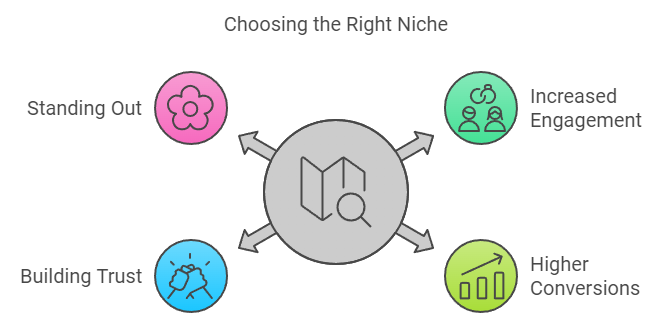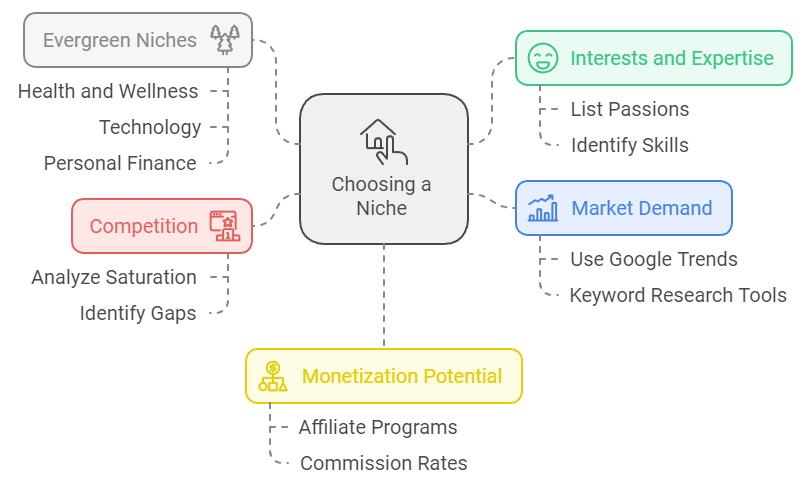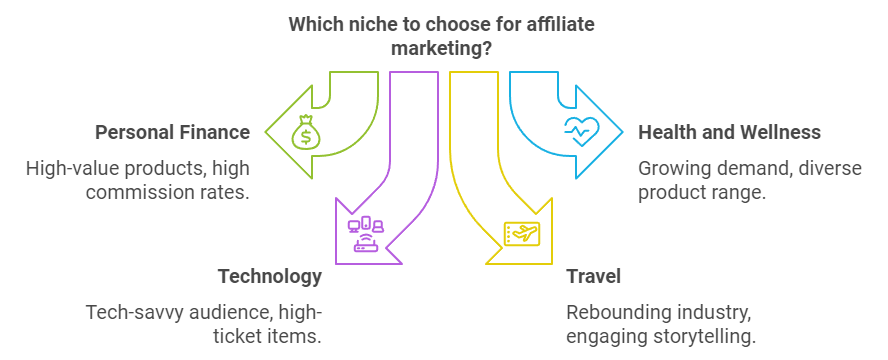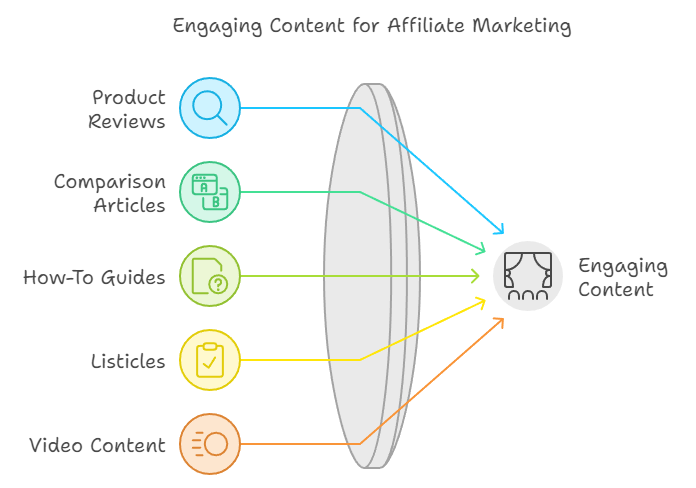Are you looking for a flexible way to generate extra income without giving up your full-time job? Affiliate marketing might be the perfect solution. It’s a low-cost, scalable business model that allows you to earn commissions by promoting products or services you love.
In this guide, we’re going to walk you through affiliate marketing from the ground up. By the end, you’ll have a clear, actionable plan to build a profitable affiliate business that fits seamlessly into your lifestyle. Whether you’re a complete newbie or someone who’s been curious about affiliate marketing for a while, this step-by-step guide will help you get started quickly and confidently.
So, if you’re ready to take control of your financial future, let’s dive into the world of affiliate marketing for beginners and start building your own path toward success!
Step 1—Choose a Niche
Why Choosing the Right Niche is Critical
Choosing the right niche is one of the most important decisions you’ll make as an affiliate marketer. A well-chosen niche isn’t just about picking something you’re passionate about—it also needs to align with your audience’s interests. When you find that sweet spot, it significantly increases the likelihood of engagement and conversions because you’re speaking directly to what they care about.
Focusing on a specific niche allows you to create targeted, high-quality content that resonates with your audience. This builds trust and boosts your credibility. People are more likely to follow your recommendations when they see that you’re knowledgeable and consistent within a particular area.
Additionally, opting for a less saturated niche gives you the opportunity to stand out. When you’re not competing with thousands of other marketers, it’s easier to rank higher in search results, attract attention, and build a loyal following.

Market Value and Growth
- The global affiliate marketing industry was valued at $17 billion in 2023 and is projected to grow to $27.78 billion by 202724.
- In the United States, affiliate marketing spending reached $8.2 billion in 2024, reflecting a year-over-year increase of 10.8%12.
Take a look at related articles by me:
Steps to Choose a Niche
Identify Your Interests and Expertise
The first step in choosing your niche is to look inward. Start by listing areas you’re passionate about or have expertise in. Picking a niche that excites you will make content creation more enjoyable and sustainable over time. When you genuinely care about a topic, it shows in your work, and your audience will be able to feel that authenticity.
Research Market Demand
Once you’ve narrowed down your interests, it’s time to see if there’s actual demand for them. Use tools like Google Trends, Ubersuggest, and keyword research tools to gauge search volumes and interest levels in potential niches. The key is to find niches that are not only popular now but have the potential for long-term growth. Look for consistent demand or upward trends, which indicate that the niche has staying power.
Analyze Competition
Before jumping into a niche, take a moment to analyze the competition. You would rather not choose a niche that’s overly saturated with established players, as this makes it harder to stand out. On the other hand, a niche with little competition might indicate a lack of demand. Aim for a niche with moderate competition—one where you can carve out your own space without being overshadowed.
Assess Monetization Potential
Now, consider the earning potential within your niche. Ensure that there are sufficient affiliate programs that offer good commission rates and various products. The more affiliate opportunities there are, the better your chances of making consistent commissions.
Consider Evergreen Niches
Lastly, consider focusing on evergreen niches—those that maintain steady demand over time, regardless of trends or seasonality. Niches like health and wellness, technology, and personal finance are prime examples. These niches are always relevant, which means you can generate income consistently rather than relying on fleeting trends.

Popular Affiliate Marketing Niches
When starting out in affiliate marketing, choosing a niche that offers high demand and strong monetization potential is key. Here are some of the most popular and lucrative niches to consider:
Personal Finance
In the personal finance niche, high-value products such as credit cards, investment tools, and financial services offer some of the highest commission rates. Audiences in this niche are often investigating how to manage money, invest wisely, or save for the future, making it a prime market for affiliate marketers.
Health and Wellness
With people becoming more health-conscious, the demand for products related to fitness, nutrition, mental health, and overall well-being is growing. This broad category offers countless opportunities to promote everything from workout gear to supplements and mental health apps. It’s a consistently strong market with plenty of affiliate programs to select from.
Adoption and Usage
Technology
If you’re tech-savvy, the technology niche offers vast opportunities. You can promote gadgets, software applications, or SaaS products to an audience always on the lookout for the next big thing. Tech enthusiasts are frequently willing to spend on high-ticket items, leading to higher commissions for affiliates.
Travel
The travel industry is bouncing back, and with it comes a wealth of affiliate opportunities. From booking platforms and travel gear to experiences and tours, there are endless ways to promote travel-related services. This niche thrives on storytelling, making it highly engaging for content creators.
Beauty and Fashion
Beauty and fashion products are in constant demand, making this a highly profitable, though competitive, niche. Whether it’s promoting skincare, makeup, or the latest fashion trends, beauty and fashion affiliates can tap into a massive audience that’s always looking for the next must-have product.

Balancing Passion and Profit
Finding the right balance between passion and profitability is crucial for long-term success in affiliate marketing. While it’s important to choose a niche that genuinely interests you, it’s equally essential to ensure that the niche has the potential to generate income. Passion can fuel authentic content creation, making your work more engaging and enjoyable for both you and your audience. However, without sufficient market demand, it may be challenging to turn that passion into profit.
Before fully committing to a niche, take the time to research its profitability. Are there enough affiliate programs offering good commissions? Is there consistent demand for products or services in this area? The ideal niche allows you to blend your personal interests with the opportunity to generate a sustainable income. This balance is key to staying motivated while growing a profitable affiliate business.
Recommended Resources
To help you dive deeper into finding the right niche for your affiliate marketing journey, here are some valuable resources that provide expert insights and guidance:
- Shopify Blog: Explore some of the best affiliate marketing niches and understand what makes them profitable.
Shopify Blog: Best Affiliate Marketing Niches - GetResponse Blog: Learn how to choose the right affiliate niche that aligns with both your passion and profitability.
GetResponse Blog: How to Choose Your Affiliate Niche - Affilorama: This resource covers the importance of selecting the right niche, with practical tips for market research and competition analysis.
Affilorama: Importance of Choosing the Right Niche
Step 2—Set Up Your Platform
Choose Your Platform Type
When it comes to affiliate marketing, selecting the right platform is crucial for reaching your audience and optimizing your efforts. There are several effective options, each with its own strengths:
Website or Blog
Creating a dedicated website or blog gives you full control over your content and affiliate links. It allows you to build a personal brand, optimize for SEO, and present a professional online presence. A well-structured blog with regular, high-quality content can help you rank on search engines and attract organic traffic. This method is ideal for long-term growth and building credibility in your niche. WPBeginner – Beginners Guide
Social Media
If you have a strong following on platforms like Instagram, YouTube, or TikTok, social media can be an effective way to promote affiliate products. These platforms are perfect for creating engaging content that quickly connects with your audience. From product reviews to how-tos, social media allows for dynamic and interactive promotions, often with instant feedback from your followers.
Email Marketing
Building an email list allows you to connect directly with your audience in a more personalized way. Through regular newsletters or promotional emails, you can share affiliate links while offering valuable content to your subscribers. This method is particularly effective for nurturing leads over time and driving repeat engagement. Hostinger – How to Start Affiliate Marketing
Build Your Website
Domain and Hosting
The first step in building your affiliate marketing website is choosing a domain name that reflects your niche and is easy to remember. A good domain name should be short, relevant, and unique, helping your audience immediately understand what your site is about. Once you’ve settled on a domain name, you’ll need reliable hosting services. Platforms like Bluehost or Hostinger are popular choices because they offer affordable packages and easy WordPress integration—perfect for beginners looking to set up quickly without technical headaches.
Website Design
Now that you have your domain and hosting in place, it’s time to design your website. Using platforms like WordPress makes this process easy, even for non-tech-savvy users. Start by selecting a responsive theme that aligns with your brand identity. Ensure your website is visually appealing and easy to navigate, with a clean layout that enhances the user experience. A well-designed site keeps visitors engaged and helps improve your SEO rankings, making it easier for people to find your content.
Performance and Revenue
- The average return on ad spend (ROAS) for affiliate marketing is approximately 12:1, indicating its cost-effectiveness.
- Affiliate marketing contributes to 23% of all e-commerce sales, underscoring its importance as a sales channel.
- High-ticket items and digital products often offer the highest commissions, ranging from 20% to 50%.
Essential Pages
A successful affiliate marketing website isn’t just about product promotion—it’s about building trust with your audience. Be sure to include key pages like:
- About Us: Share your story and explain why your recommendations are trustworthy. This helps establish credibility and a personal connection with your readers.
- Contact: Offer a way for visitors to get in touch with you, whether through email or a contact form. This makes your site feel more professional and approachable.
- Privacy Policy: A must-have for compliance with legal requirements, this page assures your audience that their data is handled responsibly.
- Resources or Recommendations: This page can be dedicated to showcasing the affiliate products and services you recommend, making it easy for visitors to find and click on your affiliate links.
By setting up these essential pages, you’re creating a solid foundation for your affiliate business, while also ensuring your website is professional and trustworthy.
Optimize for SEO
Keyword Research
One of the most critical steps in driving organic traffic to your affiliate site is proper keyword research. Identifying the right keywords helps improve your search engine rankings, making it easier for your audience to find your content. Tools like Google Keyword Planner, Ahrefs, and SEMrush can assist in finding high-volume, low-competition keywords relevant to your niche. Focus on long-tail keywords—phrases that are more specific and often easier to rank for. These keywords will guide your content creation and ensure your site attracts the right audience.
On-Page SEO
Once you’ve identified your keywords, it’s time to optimize your website for search engines. This process, known as on-page SEO, involves several important factors:
- Meta Titles: Ensure each page has a unique, keyword-rich title that reflects the content and attracts clicks from search results.
- Meta Descriptions: Write compelling descriptions that include your primary keywords and give users a reason to visit your site.
- Header Tags: Use H1, H2, and H3 tags to structure your content and make it easy for both users and search engines to navigate. Make sure each header includes relevant keywords.
- Internal Linking: Link to other relevant pages within your site to guide visitors through your content and keep them engaged. Internal linking helps improve SEO by passing authority between pages.
Content Strategy
To sustain traffic growth, you need a well-thought-out content strategy. This includes creating a mix of product reviews, how-to guides, and tutorials that target specific keywords. Each piece of content should be fully optimized with keywords in strategic places like titles, headers, and throughout the text. Additionally, make sure to include meta tags and use internal links to other related posts, which enhances the user experience and boosts SEO. By consistently posting high-quality, keyword-rich content, you’ll increase your visibility and rank higher in search results.
Demographics and Trends
- Individuals aged 35 to 44 make up 32% of the total affiliate marketing industry, followed by those aged 25 to 34 at 24%.
- Mobile devices account for over 50% of affiliate traffic, highlighting the need for mobile-optimized strategies.
Integrate Affiliate Tools
Affiliate Plugins
Managing your affiliate links efficiently is essential for a smooth user experience and maximizing your earnings. Plugins like ThirstyAffiliates or Pretty Links can help you organize, cloak, and shorten long affiliate URLs into more attractive, branded links. Cloaking your affiliate links makes them more visually appealing and helps build trust with your audience by showing clean, concise URLs. Additionally, these tools allow you to easily update or change links across your site if needed, saving time and avoiding broken links.
Analytics Tools
To effectively grow your affiliate marketing business, tracking and analyzing visitor behavior is key. Google Analytics is a powerful tool that provides valuable insights into your site’s performance, including which pages and links are driving the most traffic and conversions. You can monitor how long visitors stay on your site, what they’re clicking on, and how often they convert. This data allows you to identify what’s working and refine your marketing strategy accordingly. By understanding visitor behavior, you can optimize your content and link placements for better performance.
Email Marketing Tools
Building and maintaining an email list is one of the most effective ways to connect with your audience and drive affiliate sales. Email marketing services like Mailchimp or GetResponse allow you to manage your subscriber list, segment audiences, and send targeted email campaigns. These tools also offer automation features, enabling you to send personalized messages or promotions based on user behavior or preferences. A well-managed email list can be a direct line to your most engaged audience, offering a personal touch and boosting your chances of converting subscribers into paying customers.
Recommended Resources
Here are some expert resources to help you further explore tools and strategies for successful affiliate marketing:
- Hostinger: Learn how to start affiliate marketing from scratch and discover essential tools to optimize your efforts.
Hostinger: How to Start Affiliate Marketing in 2024 - WPBeginner: A comprehensive guide for beginners, offering valuable affiliate marketing tips and tools to get you started.
WPBeginner: Affiliate Marketing Tips & Tools
Step 3—Find Affiliate Programs
Understand the Types of Affiliate Programs
When you’re diving into affiliate marketing, one of the first things to understand is the two main types of affiliate programs. Picking the right type can make a big difference in how you promote products and earn commissions.
Affiliate Networks
Affiliate networks connect you with tons of merchants offering products or services across different niches. These platforms are super handy because they provide you with access to a massive variety of affiliate programs all in one place. Networks like ShareASale, CJ Affiliate, and Rakuten Advertising make it easy to track your earnings and manage multiple offers without juggling a million different accounts. They’re great for beginners since everything is organized for you—you can choose what works best for your niche and start earning in no time.
Direct Affiliate Programs
Want a more personal touch? Direct affiliate programs are run by companies themselves, which means you work directly with the brand. No middleman, just higher commissions and exclusive support! Programs like Amazon Associates or Shopify’s affiliate program give you access to well-known products and some sweet commissions. If you’re ready to build a strong partnership with a specific brand, these are the programs to jump on.
Evaluate Affiliate Programs
Not all affiliate programs are created equal, so it’s important to evaluate a few key factors before signing up. Picking the right program can make a huge difference in your earnings and long-term success.
Commission Rates
One of the first things to look at is the commission rate. Some programs offer as much as 50% commissions, like Leadpages and ClickFunnels, which means you can earn a significant amount with every sale. However, most programs will vary, so it’s worth comparing commission structures across different options. Always aim for programs that offer competitive rates in your niche to maximize your earnings potential.
Cookie Duration
The longer the cookie duration, the better. A cookie is what tracks user activity after they click your affiliate link. Programs with longer cookie durations allow you more time to earn a commission, even if the buyer doesn’t purchase right away. For example, FlexOffers offers cookie durations up to 120 days, giving you a better chance of securing the sale.
Payment Methods and Thresholds
It’s also important to check how and when you get paid. Does the program offer convenient payment methods like PayPal or direct deposit? And what’s the minimum threshold to receive your earnings? Look for programs with reasonable payment thresholds so you’re not waiting forever to cash out your commissions. Many programs offer thresholds as low as $50, which is ideal for beginners.
Product Relevance
Lastly, make sure the products or services being offered align with your niche and audience’s interests. When your audience trusts that your recommendations are relevant and useful, they’re more likely to convert. Always choose affiliate programs that offer products or services you genuinely believe in and that will appeal to your audience’s needs.
Join Reputable Affiliate Networks
When you’re just starting out in affiliate marketing, partnering with a reputable affiliate network can make a big difference in how easily you find success. Here are a few well-known networks that are perfect for beginners:
ShareASale
With its user-friendly interface and an extensive range of products, ShareASale is a top choice for beginners. It’s easy to navigate, even if you’re entirely new to affiliate marketing, and it offers plenty of options across various niches. You can start promoting products right away, thanks to its simple setup and tools.
CJ Affiliate (Commission Junction)
Looking for variety? CJ Affiliate offers one of the largest selections of merchants, making it perfect for finding products that fit your niche. It also provides detailed tracking tools, so you can monitor how your campaigns are performing and optimize as you go. If you’re interested in working with big brands, CJ is definitely worth considering.
ClickBank
If you’re leaning towards digital products, ClickBank is a powerhouse in this space. It specializes in high-commission digital products, making it a great choice if you want to focus on promoting eBooks, courses, or software. ClickBank is especially ideal for affiliates in the digital marketing niche, offering attractive payouts and a solid reputation.
Affiliate Networks
Explore Niche-Specific Programs
When you narrow down your niche, finding affiliate programs tailored to your specific audience can give you a competitive edge. Here are some niche-specific programs that offer solid commissions:
Tech Products
If your niche is tech-related, programs like Bluehost and Elementor are top choices. They offer high commissions and are well-known brands in the tech world. Whether you’re promoting web hosting or website-building tools, these programs are ideal for tech-savvy audiences who are ready to invest in the right products.
Health and Wellness
In the booming health and wellness industry, programs like Market Health offer a wide range of health-related products, from supplements to skincare. This niche is always in demand, and Market Health provides competitive commission rates, making it a lucrative option for affiliates focused on promoting fitness, nutrition, or overall well-being.
E-commerce Platforms
For those in the e-commerce niche, Shopify is a great affiliate program to explore. Shopify provides excellent tools and resources for affiliates, and their platform is a go-to for entrepreneurs looking to set up online stores. The combination of high demand and Shopify’s reputation makes this an attractive program to promote.
Leverage Affiliate Directories
Finding the right affiliate programs can be time-consuming, but using affiliate directories can make the process much easier. Platforms like OfferVault and AffiliatePrograms.com allow you to browse and compare a wide range of affiliate opportunities across various industries. These directories are great tools for discovering new programs that fit your niche and audience. With advanced search filters and detailed program comparisons, you can quickly find the best offers, commission rates, and product categories to promote. These platforms simplify the search, helping you focus on the opportunities that will generate the best returns.
Recommended Resources
Looking for more tips on finding the best affiliate programs? Check out these expert resources:
- Diggity Marketing: Discover some of the top affiliate programs for beginners, with in-depth reviews and recommendations.
Diggity Marketing: Best Affiliate Programs for Beginners - Authority Hacker: A comprehensive guide to affiliate marketing programs that are perfect for beginners.
Authority Hacker: Best Affiliate Marketing Programs for Beginners - Shopify Blog: Explore Shopify’s guide to the best affiliate programs for marketers across various niches.
Shopify Blog: Best Affiliate Programs for Marketers
Step 4—Create Quality Content
Creating quality content is at the heart of successful affiliate marketing. It’s not just about attracting and engaging your audience—it’s about building trust so they feel confident clicking on your affiliate links. Here are key strategies and content formats to keep in mind:
Understand Your Audience
Research Audience Needs
To create content that resonates, you need to understand what your audience is searching for in your niche. Tools like Google Analytics and social media insights can help you identify their interests, pain points, and behavior patterns. By gaining this more in-depth understanding, you’ll be able to tailor your content to meet their needs and answer their burning questions.
Tailor Content
Once you know what your audience is looking for, create content that addresses these specific needs. Provide valuable solutions and actionable information that directly resonates with them. The more relevant and helpful your content, the more likely your audience is to engage with it and trust your recommendations.

Choose Engaging Content Formats
Product Reviews
Offering detailed reviews of products, highlighting their features, benefits, and any potential drawbacks, helps build credibility with your audience. Honest reviews that discuss both the pros and cons create trust and authenticity.
Comparison Articles
Comparing similar products or services is an effective way to help your readers make informed decisions. This format works well to showcase the advantages of the products you’re promoting, positioning them as the better choice.
How-To Guides
Step-by-step guides are excellent for walking your audience through the process of using a product or solving a problem related to your niche. Naturally, include affiliate links within the guide to offer value while promoting relevant products.
Listicles
Lists of top products or tips are easy to read and can effectively include multiple affiliate links. They’re a great format for providing quick, digestible content while offering plenty of product recommendations.
Video Content
Platforms like YouTube or Instagram are perfect for creating engaging video content, such as tutorials, unboxings, or testimonials. Videos are highly effective in captivating your audience and conveying information in a dynamic way.

Optimize Content for SEO
Keyword Research
Use SEO tools like Google Keyword Planner, Ahrefs, or SEMrush to find keywords relevant to your niche. By incorporating these keywords naturally into your content, you improve your chances of ranking higher in search results.
On-Page SEO
To maximize visibility, optimize your content’s titles, headers, meta descriptions, and images with relevant keywords. Also, use internal linking to guide readers to related content on your site, keeping them engaged and increasing the likelihood of conversions.
Integrate Affiliate Links Effectively
Strategic Placement
For the best results, place your affiliate links where they’re most likely to be clicked. Ideally, links should appear at the beginning, middle, and end of your content to maximize visibility.
Contextual Embedding
Make sure that affiliate links are contextually relevant, blending seamlessly into your content. This ensures they add value to the reader’s experience rather than feeling improper or forced.
Call-To-Actions (CTAs)
Use strong CTAs to prompt readers to take action. Phrases like “Learn More” or “Buy Now” can be highly effective in encouraging clicks on your affiliate links.
Maintain Transparency and Trust
Honest Recommendations
Only promote products that you genuinely believe in and have experience with. This authenticity builds trust with your audience and increases the likelihood that they’ll follow your recommendations.
Affiliate Disclosures
It’s important to clearly disclose the presence of affiliate links in your content to maintain transparency and comply with legal requirements. This helps build trust with your readers by being upfront about your affiliate relationships.

Keep Content Fresh and Relevant
Regular Updates
Update your content regularly to keep it accurate and relevant. This includes adding new products, information, or affiliate links as they become available.
Seasonal Content
Stay ahead by incorporating seasonal trends or events into your content strategy. This keeps your posts timely and engaging while also offering fresh affiliate opportunities.
Recommended Resources
Here are some expert resources to guide you on promoting affiliate links and creating valuable content:
- GetResponse Blog: Learn how to promote affiliate links effectively with proven strategies.
GetResponse Blog: How to Promote Affiliate Links - EasyAffiliate Blog: Explore affiliate marketing strategies specifically designed for bloggers.
EasyAffiliate Blog: Affiliate Marketing for Bloggers - AffiliateCrafted: Dive into content creation strategies tailored for affiliate marketers.
AffiliateCrafted: Content Creation Strategies for Affiliates
Step 5—Drive Traffic to Your Content
Driving traffic to your content is essential for affiliate marketing success. Even the best content won’t generate income if no one sees it. Here are some effective strategies to increase visibility and attract potential customers to your site:
Optimize for Search Engines (SEO)
Keyword Research
The foundation of successful SEO is effective keyword research. Use tools like Ahrefs, Google Keyword Planner, or SEMrush to find long-tail keywords that are easier to rank for and more likely to convert. Long-tail keywords are more specific, meaning they often attract a more targeted audience. For example, instead of targeting a broad term like “affiliate marketing,” you might aim for “affiliate marketing tips for beginners.” These keywords typically have less competition and higher conversion potential.
On-Page SEO
On-page SEO involves optimizing individual pages on your website to rank higher in search results. Key elements to focus on include:
- Titles: Craft engaging, keyword-rich titles that clearly describe what the content offers.
- Meta Descriptions: These should also include relevant keywords and provide a brief, compelling summary of your content.
- Headers: Use H1, H2, and H3 tags to structure your content and include keywords where appropriate. Well-structured content improves SEO and enhances user experience.
- Image Alt Texts: Optimize images by using descriptive alt texts that include keywords. This helps your images rank in search engines and enhances accessibility.
- Internal Links: Keep readers engaged by linking to related content on your site. This helps improve user experience and boosts your site’s overall SEO by distributing page authority.
Backlinks
Building backlinks is another key element of SEO. Backlinks are links from other websites that direct users to your content. Search engines view backlinks as a sign of credibility, and sites with more high-quality backlinks typically rank higher in search results. Focus on creating high-quality, shareable content that other websites will naturally want to link to. You can also reach out to relevant sites or blogs for guest posting opportunities, which can drive both traffic and backlinks.

Leverage Social Media
Social media is a powerful tool for driving traffic to your content and affiliate links. By choosing the right platforms and engaging effectively with your audience, you can significantly boost your visibility and conversions.
Platform Selection
Selecting the appropriate social media platforms is essential to reach your target audience. Different platforms cater to different demographics, so it’s important to align your efforts with the platforms your audience uses the most. For instance, Instagram and TikTok are popular among younger audiences and are great for visual content like short videos and images. If your target audience skews older or more professional, platforms like Facebook and LinkedIn might be more effective. The key is to focus on the platforms that best match your niche and the types of products you’re promoting.
Engagement
Building an active community on social media is crucial for success. Engage with your audience by responding to comments, answering questions, and encouraging conversations around your content. Sharing user-generated content—such as posts or stories from your followers—helps create a sense of community and increases engagement. This interaction builds trust and encourages followers to share your content with others, expanding your reach organically.
Content Types
To capture attention on social media, you need to use content formats that resonate with your audience. Videos and infographics tend to perform particularly well, as they are visually engaging and easy to consume. Whether you’re creating a product review, a how-to tutorial, or a list of tips, using these formats can make your posts more shareable and impactful. Always include call-to-actions (CTAs) in your posts, encouraging users to click through to your affiliate links or visit your website for more information.
Here’s the table showing different social media platforms and their ideal content formats:
| Social Media Platform | Ideal Content Formats | Audience Demographics |
| Photos, Stories, Short Videos (Reels), IGTV | Younger audience (18-34), highly visual | |
| TikTok | Short-form Videos (15-60 seconds), Challenges | Gen Z and Millennials, highly creative |
| Images, Long-form Videos, Text Posts, Groups | Older audience (25+), community-oriented | |
| YouTube | Long-form Videos, Tutorials, Vlogs | Broad audience (teens to adults), visual |
| Infographics, Step-by-Step Guides, Visual Pins | Predominantly female, interest-driven | |
| Articles, Professional Tips, Case Studies | Professionals and B2B audience | |
| Twitter (X) | Short Text Posts, GIFs, News Updates | Broad audience, quick information seekers |
Utilize Email Marketing
Email marketing is one of the most effective ways to build lasting relationships with your audience while driving traffic and conversions for your affiliate marketing efforts. Let’s explore how to maximize its potential:
Build an Email List
The first step in leveraging email marketing is building a subscriber list. Offering lead magnets—such as e-books, webinars, or checklists—can be an enticing way to encourage people to sign up. These free resources should be valuable and relevant to your niche, providing solutions or tips that your audience finds helpful. As your list grows, you’ll have a direct line of communication with people who are genuinely interested in your content, which makes them more likely to engage with your affiliate offers.
Regular Newsletters
Once you’ve built your email list, sending regular newsletters helps keep your audience engaged. These newsletters should provide valuable content tailored to your subscribers’ preferences. By embedding affiliate links in your emails, you can seamlessly promote relevant products while offering useful information. For best results, personalize your emails based on your subscribers’ behaviors, such as what they’ve clicked on in the past or topics they’ve shown interest in. This personalized approach increases engagement and builds trust, making it more likely that your subscribers will click through to your affiliate links.

Write Guest Posts
Guest posting is a powerful strategy to expand your reach, build credibility, and drive traffic to your affiliate content. By collaborating with established blogs, you can tap into an existing audience while providing value to their readers.
Collaborate with Established Blogs
The key to successful guest posting is selecting reputable sites in your niche. Writing for blogs that are already trusted by their audience gives you instant credibility. Focus on finding blogs that align with your niche and have an engaged readership. Collaborating with these sites allows you to introduce your expertise and content to a broader audience, ultimately driving more traffic to your own site.
Include Links
When writing guest posts, it’s essential to strategically place affiliate links within the content. These links should be contextually relevant, leading readers to your site or directly to the affiliate products you’re promoting. Ensure that the links are naturally embedded and add value to the reader, increasing the chances of click-throughs and conversions. Always follow the blog’s linking guidelines and disclose any affiliate relationships to maintain transparency.

Participate in Online Communities
Getting involved in online communities is a great way to drive traffic to your affiliate content. By providing valuable insights and engaging with users, you can build trust and encourage people to check out your site and affiliate links.
Forums and Q&A Sites
Platforms like Reddit, Quora, and niche-specific forums offer a space to engage directly with your target audience. The key is to provide insightful answers to questions that are relevant to your niche. When appropriate, you can subtly promote your affiliate links by offering them as a solution. It’s important not to spam, but to focus on delivering genuine value that naturally encourages users to click on your links. These platforms are great for establishing credibility and reaching new potential customers.
Community Building
To truly make an impact, consistency is key. Regularly contribute valuable information and engage in discussions, establishing yourself as an expert in your niche. This positions you as a go-to resource within the community, making users more likely to follow your recommendations and visit your site. As you build authority, members will start to recognize and trust your contributions, leading to increased traffic and affiliate conversions.
Invest in Paid Advertising
Paid advertising can be a game-changer for driving targeted traffic to your affiliate content. With the right strategies, you can boost visibility and conversions quickly by reaching people who are most likely to engage with your products.
Social Media Ads
Platforms like Facebook Ads allow you to target specific demographics that align with your niche products. You can zero in on audiences based on factors like age, location, interests, and behaviors. To make the most of these ads, craft engaging visuals and compelling ad copy that resonates with your audience and encourages them to click on your affiliate links. For example, using high-quality images or videos alongside a clear call-to-action (CTA) can make your ads more impactful and increase click-through rates.
Retargeting Campaigns
Not all visitors convert the first time they land on your site, and that’s where retargeting ads come in. These ads are designed to target users who have previously visited your site but didn’t complete a purchase or take action. With retargeting, you can remind them of the product or offer, often using incentives like discounts to encourage them to return and convert. This is an effective way to recover lost leads and boost your overall conversions.
Here’s the table showing different types of paid ads and when to use them:
| Ad Type | Best Used For | Description |
| Social Media Ads | Targeting specific demographics or interests | Platforms like Facebook, Instagram, and TikTok allow precise targeting based on user interests and behavior. |
| Google Search Ads | Capturing high-intent searches for specific products or services | These ads appear when users search for keywords related to your niche, capturing potential customers at the moment of interest. |
| Display Ads | Increasing brand visibility across websites | Visual ads displayed on websites in the Google Display Network or other networks to increase awareness. |
| Retargeting Ads | Re-engaging visitors who didn’t convert on their first visit | Targets users who have visited your site before, reminding them of the products or offers they viewed. |
| Shopping Ads | Promoting individual products with a focus on e-commerce | Google Shopping or other shopping platforms, showcasing specific products to users searching for those items. |
| Video Ads | Engaging audiences with dynamic video content | Used on platforms like YouTube or social media to promote products through tutorials, testimonials, or ads. |
Recommended Resources
If you’re looking to learn more about driving traffic and maximizing your affiliate marketing efforts, here are some expert resources to check out:
- ThirstyAffiliates: Generate traffic for affiliate marketing with actionable strategies.
ThirstyAffiliates: Generate Traffic for Affiliate Marketing - GetResponse: Learn how to promote affiliate links effectively and get the most out of your campaigns.
GetResponse: Promote Affiliate Links - Lemlist: Dive into affiliate marketing strategies that work across different platforms and industries.
Lemlist: Affiliate Marketing Strategies
Step 6—Monitor Your Performance
Monitoring your performance is a crucial step in affiliate marketing. By tracking and analyzing your efforts, you’ll gain insights into what strategies are working and where improvements are needed. Here are key strategies and tools to help you effectively monitor and optimize your affiliate marketing campaigns:
1. Set Clear Goals and KPIs
To measure success, you need to establish clear objectives for your affiliate marketing campaigns. These could include goals like increasing traffic, improving conversion rates, or boosting revenue.
- Define Objectives: Be specific with what you want to achieve, whether it’s a 10% increase in traffic or doubling conversions.
- Identify Key Performance Indicators (KPIs): Track important metrics such as clicks, conversions, revenue, and return on investment (ROI) to measure how well you’re reaching your goals.
2. Use Analytics Tools
Analytics tools are essential for tracking performance and understanding user behavior.
- Google Analytics: This free tool offers comprehensive insights into website traffic, user behavior, and conversion tracking. You can set up specific goals and events to measure actions related to affiliate links, such as clicks and purchases.
- Affiliate Network Dashboards: Most affiliate networks provide dashboards with detailed reports on clicks, sales, and commissions. These dashboards help you track performance across different programs and offers, giving you a clear view of what’s working.
3. Implement Conversion Tracking
Tracking conversions helps you understand which strategies and promotions drive the best results.
- Conversion Pixels: Use tracking pixels or codes to monitor user actions after they click on your affiliate links. This allows you to see which products or campaigns are generating the most conversions.
- SubID Tracking: Add SubIDs to your affiliate links to track specific elements like placement, format, or promotional channels. This will help you determine which parts of your content generate the most revenue.
4. Leverage Third-Party Tools
Using advanced third-party tools can help you track and optimize your campaigns more efficiently.
- Voluum: A robust tool for tracking ad campaigns across multiple traffic sources. It offers features like trend analysis and anti-fraud detection, giving you deep insights into performance.
- Tapfiliate: This tool provides real-time analytics for tracking conversions and optimizing affiliate strategies. It supports various commission models and integrates seamlessly with eCommerce platforms.
- AffJet: Ideal for affiliates managing multiple networks, AffJet consolidates data from different affiliate networks into one dashboard, offering detailed performance reports.
5. Analyze and Optimize
Regularly reviewing your data and making adjustments is key to long-term success.
- Regular Reviews: Look for trends and patterns in your data to identify what’s working. Focus on high-performing content or campaigns and find ways to replicate or scale them.
- A/B Testing: Test different elements of your content or landing pages (e.g., headlines, CTAs, images) to determine what drives better engagement and conversions.
6. Make Data-Driven Decisions
Use the insights gained from your monitoring tools to make informed decisions about your marketing strategies. Focus on scaling successful campaigns and adjusting or discontinuing those that are underperforming. Data-driven decisions will help you optimize your efforts, engage your audience more effectively, and increase earnings.
Recommended Resources
Here are some expert resources to help you dive deeper into monitoring your affiliate marketing success:
- FasterCapital: Tools for monitoring affiliate marketing success.
FasterCapital – Tools for Monitoring Affiliate Marketing Success - Hostinger: The top 19 affiliate marketing tools for tracking and optimizing your campaigns.
Hostinger – The Top 19 Affiliate Marketing Tools - Tapfiliate: A guide to the best affiliate marketing tools for performance tracking.
Tapfiliate – A Guide to the Best Affiliate Marketing Tools - Hostinger: Learn how to start affiliate marketing in 2024 with detailed tips and tools.
Hostinger – How to Start Affiliate Marketing in 2024
Step 7 – Comply with Regulations
Staying compliant with regulations is critical in affiliate marketing. The Federal Trade Commission (FTC) requires that affiliates clearly disclose their relationships with merchants to maintain transparency and trust with their audience. Non-compliance can lead to penalties and damage your reputation, so it’s essential to follow these guidelines.
How to Stay Compliant with FTC Guidelines
To ensure compliance, you need to be upfront about your use of affiliate links. Whenever you promote products or services through affiliate links, you must clearly disclose that you may earn a commission if visitors make a purchase through those links. This helps maintain transparency and builds trust with your audience.
A simple way to disclose affiliate links is to place a statement at the top of your blog posts, emails, or social media content. Here are some sample disclosure statements you can use on your site:
- “This post contains affiliate links. If you click on them and make a purchase, I may earn a small commission at no extra cost to you.”
- “As an affiliate, I may earn commissions from qualifying purchases.”
Make sure the disclosure is easy to spot and not hidden deep within your content.
FAQ Section
Affiliate marketing is a business model where you promote products or services through a unique affiliate link. When someone clicks your link and makes a purchase, you earn a commission. It works by partnering with companies or affiliate networks, finding products in your niche, and sharing them with your audience.
To decide the best niche, start by identifying areas you are passionate about or knowledgeable in. Research market demand using tools like Google Trends and analyze the competition. A profitable niche strikes a balance between your interests and monetization potential, with a clear target audience.
To drive traffic, focus on SEO, keyword research, and creating valuable content. Leverage social media platforms, engage in online communities, and use email marketing to reach your audience. Paid ads, like Facebook or Google Ads, can also be used to attract more visitors to your site.
Some of the best affiliate marketing programs for beginners include ShareASale, CJ Affiliate, and Amazon Associates. These platforms are easy to use, offer a wide range of products, and provide reliable tracking and payments, making them ideal for new affiliates.
While having a website is highly recommended for building a brand and SEO, it’s not strictly necessary. You can start affiliate marketing using social media platforms, YouTube, or email marketing to promote products and earn commissions without a dedicated website.
Conclusion
Starting affiliate marketing might seem overwhelming at first, but by breaking it down into clear steps—choosing the right niche, setting up your platform, creating high-quality content, driving traffic, and consistently monitoring your performance—you can build a profitable and sustainable business. The effort you put in now can lead to a reliable income stream over time, offering flexibility and financial freedom.
Ready to kick off your affiliate marketing journey? Take the first step today by picking your niche and exploring beginner-friendly affiliate programs. Affiliate marketing for beginners has never been easier—start now and watch your online business grow!











Leave a Reply